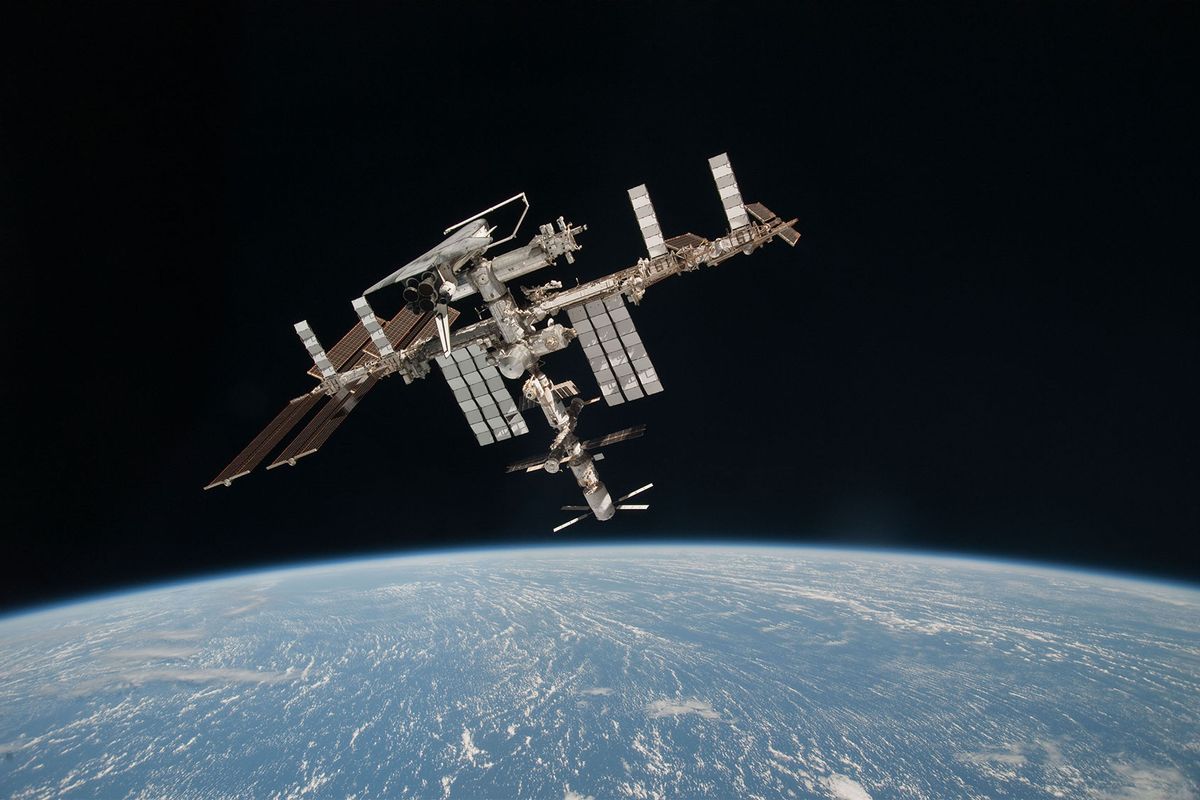NASA’s plan to crash and burn the ISS explained and what space commercialization means for science

In a few short years, some of us will be able to look up at the sky and see a flaming dot roar toward the Earth and crash into the ocean. In that dot will be 30 years of international scientific cooperation between nations that are more often at each others’ throats than in each others’ labs. As the dot gets closer, we’ll see the burning fragments of the International Space Station modules — and maybe even some other countries’ modules that we bring down with us.
Congress has authorized ISS operations into 2030, though budget fears still hover over some in the field. NASA’s latest public relations sprint, however, is geared toward finding commercial contractors that can tug the U.S. modules back to earth for a splashdown. And those which can privatize such low-orbit destinations, demoting NASA’s role from that of public creator to private customer.
The ISS is designed for international interdependence, though. Yanking a 1998-era chunk of US space tech out of an intricately grafted hive of engineering without destroying the whole thing may not even be possible. And so far, NASA has not announced any planned impact on partner nation modules.
The ISS is designed for international interdependence.
Meanwhile, the race toward space station commercialization is tightening up. Massive corporations like Northrop Grumman, Blue Orbit, SpaceX and others are competing for a publicly funded foothold in a surging private sector. The State Department estimates that the global space economy is worth $348 billion, accounting for more than 200,000 US jobs across sectors from manufacturing to telecoms and earth observation. The satellite industry alone is worth about 79% of that total economy.
NASA is now asking U.S. companies for input on its upcoming rules for commercial space stations in low-earth orbit — destinations available to NASA once the ISS is retired — with an industry briefing scheduled for Oct. 12.
“This RFI is a significant next step in transitioning low Earth orbit operations to the private sector, allowing NASA to be one of many customers for services” said NASA’s commercial spaceflight director, Phil McAlister, in an Oct. 2 release. NASA did not immediately return Salon’s request for comment.
Amid the ups and downs of the U.S. commercial space station frenzy, Chinese and Russian government space efforts have also been shifting gears.
Want more health and science stories in your inbox? Subscribe to Salon’s weekly newsletter Lab Notes.
China announced Thursday that it would expand its Tiangong space station into six modules, aiming to provide an ISS alternative by 2030. The expansion marks a reversal of the country’s prior plans for Tiangong, also known as the Chinese Space Station (CSS), which was launched in 2019. The same year, the United Nations confirmed that institutions from Germany, Switzerland, India, Russia and others would be participating in experiments on the CSS.
China’s scientists have been banned from the ISS since 2011, when the U.S. Defense Dept budget bill barred NASA from using any funds to collaborate at all with Chinese scientists unless specifically authorized by Congress.
What hope is left for international cooperation in space when we can’t even get our astronauts in the same vessel?
The news came on the heels of a delay announced by the Russian government, whose financing issues have slowed the country’s development of a new low-orbit space station. On Oct. 2, Russian space agency Roscosmos said the delays have prompted a search for international partners.
After nearly 23 years of continuous human occupation, the politically messy divorce and destruction of what was once the hopeful icon of international scientific pursuit begs the question: What hope is left for international cooperation in space when we can’t even get our astronauts in the same vessel?
And, more precisely, what is the U.S. push toward low-orbit privatization signaling about our future pursuits in space?
Expanding the military-industrial-space complex
In a May release, the Office of Space Affairs touted 24 signatories to the international accords launched in 2020, aimed at enhancing international scientific cooperation in the run up to NASA’s 2024 moon-return mission.
“The Artemis Accords stand at the center of our civil space diplomatic efforts. Grounded in the Outer Space Treaty of 1967, the Accords are a multilateral, non-binding declaration of principles to guide safe and transparent civil space exploration and promote peaceful cooperation in space exploration and scientific endeavors,“ said Jennifer Littlejohn, an acting assistant bureau secretary.
The same month, the State Dept. released its first-ever Strategic Framework for Space Diplomacy, a blueprint for navigating increasingly choppy international relations in space exploration. Citing the 2023 Threat Assessment report from the Director of National Intelligence, the Space Affairs framework threads a narrow needle between the interests of U.S. political and military wrangling — and the interests of actually doing space science.
The OSA positions Russian and Chinese space initiatives not as potential avenues for increased research collaboration but as competitors who are “organizing, training, and equipping their forces to undermine U.S. and allied security in space.”
The Space Affairs framework threads a narrow needle between the interests of U.S. political and military wrangling — and the interests of actually doing space science.
“China’s space activities are designed to advance its global standing and strengthen its attempts to erode U.S. influence across military, technological, economic and diplomatic spheres,” the intelligence report said, adding that China is likely to achieve world-class status in most of its space efforts by 2030. “Counterspace operations will be integral to potential People’s Liberation Army military campaigns, and China has counterspace weapons capabilities intended to target U.S. and allied satellites. China’s commercial space sector is growing quickly and is on pace to become a major global competitor by 2030.”
The OSA and State Dept. did not immediately return Salon’s requests for comment.
Russian space efforts are likewise bracketed by terrestrial threat concerns in the intelligence report.
“Russia’s cyberattack against commercial satellite communications networks in February 2022 illustrates the increasing interdependencies across space sectors as well as between the space and cyber domains,” it reads.
As far as the OSA framework is concerned, the friction created between pro-public government work and private space contracting is also feeding another tense conflict — the tug-of-war between the internationally collaborative space science aimed at collective uplift of humanity, and a weapons-hungry space science aimed to see who can extend a depressing global arms race most quickly into the stars.
“Distinct civil and military space policies and programs do not exist in all nations. New, emerging space partners balance space relationships with us and our strategic competitors. Some governments may not recognize the vulnerabilities of increased intermingling with competitors’ space industries,” the OSA writes.
“Technology transfer concerns and corresponding regulation mean an inherent necessary tension exists between our dual missions of protecting national security and promoting the U.S. space industry and the benefits of space for all.”
The passage reads as a less than subtle elbowing of other countries who may engage in international science operations with Russian and Chinese space programs and industries, though there’s no such pointed language aimed at private companies.
“Future cooperation with strategic competitors will depend on these countries’ adherence to international standards both in space and here on Earth. Increasing commercial leadership and participation mean we cannot rely solely on government-to-government diplomacy,” the report says.
Recent Defense Dept. contracts may illuminate what an increase in commercial leadership and participation may mean to the U.S. On Oct. 4, the U.S. Space Force awarded long-time ISS support contractor Booz Allen Hamilton $14.4 billion to upgrade our country’s missile warning and tracking tech, and a seven-year contract for $630 million to build out the Space Force’s surveillance operation.
“This contract will leverage Booz Allen’s capabilities and mission expertise in digital engineering, mission integration, agile software development, cybersecurity, change management, AI, and machine learning (ML) to help the Space Force achieve its vision for a Digital Service. It also demonstrates the criticality of the space domain in delivering key decision-making information to warfighters and intelligence agencies to protect the nation,” the company said in a Wednesday release.
If NASA only has the resources to explore Mars and return to the moon by sacrificing a shared public space for peaceful scientific collaboration, then the agency is indeed strapped for cash. But a cursory glance at the DOD’s budget makes it clear: We’ve got the money for protecting public scientific assets — we just don’t have the government for it.
Read more
about this topic


